Virgin Islands Sea Life: Marine Wonders
Virgin Islands sea life is one of the true wonders of the islands. The marine world is amazingly varied. Colorful animals and plants thrive in the tropical waters surrounding the Virgin Islands.
The fantastic array of underwater life has made the Virgin Islands one of the most popular places for snorkeling and scuba diving.
Without a doubt one of my absolute favorite things to do is to throw on my mask and snorkel and watch the amazing creatures that live just feet from the shore.
You'd need an entire encyclopedia to describe the full range of Virgin Islands sea life! Here are just a few of the animals and plants you're likely to see when you explore underwater.
Virgin Islands Sea Life: Turtles
There are several species of sea turtles living in the waters of the Virgin Islands. The most common are the Hawksbill, Green, and Leatherback. They come here to nest, laying their eggs on sandy, secluded beaches. All sea turtles are highly protected by law, since they're endangered species. Never harrass the turtles or their nests.
It's a real thrill to swim near a sea-turtle! On my most recent trip, I had the privilege of snorkeling right alongside a young Hawksbill turtle. He swam right up to me, and was quite willing to have me swim near him as he moved around the reef at Hawksnest Beach, St. John.
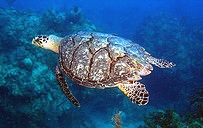
Virgin Islands Sea Life: Corals
The colorful coral reefs surrounding the Virgin Islands are some of the most diverse ecosystems anywhere. They host an almost unbelievable variety of Virgin Islands sea life, from simple single-celled creatures to giant groupers and sea turtles.
There are dozens of different kinds of corals in the waters of the islands.
Corals come in both hard and soft forms. Coral grows as colonies of small, soft individual polyps. Each polyp has a mouth-like opening surrounded by tentacles which gather nutrients from the passing water. The living coral tissue grows within and around this hard framework. The hard forms grow underlying skeletonsof calcium material.
As the soft tissue grows, it slowly forms the hard framework with it. It's a slow process; generally from one-half to four inches per year.
Soft corals grow a softer, spongy framework. They often have a flexible, plant-like appearance.
Each kind of coral grows in a distinctive shape. More often than not, the name of the coral comes from its shape.
Brain Coral grows in large individual "heads". It forms rounded or oval masses with wavy, varied surfaces that resemble a brain. You'll see brain coral ranging in size from smaller than a fingertip up to enormous heads several feet across. A brain coral of this size is hundreds of years old.
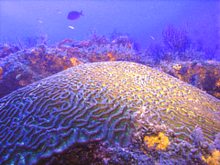
Elkhorn Coral forms clusters of flattened, antler-like structures reaching up and out toward the surface of the sea. Many small fish and other creatures take shelter among the branches of elkhorn coral.
Staghorn Coral forms long, angled "branches" which grow somewhat like a deer's antlers. Like elkhorn coral, staghorn coral forms shelter for many marine animals.
Fire Coral gets its name from the fact that it causes a firey sting or burn when touched. Unlike most coral, fire coral doesn't grow in any one fixed shape. It can grow as flat "coatings" over rocks, long, thin, finger-like forms, or rounded, antler-like structures. It has a distinctive dark mustard color with whitish tips.
Soft Corals include sea-fans and sponge-like gorgonians. They grow soft, flexible skeletons, without the hard calcium framework of the hard corals. You can see them tilting back and forth gently with the wave action on the shallow reefs.
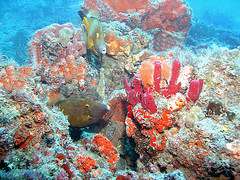
Virgin Islands Sea Life: Fish
There's a staggering array of fishes living in the waters of the Virgin Islands. They're certainly some of the most noticeable and appealing forms of Virgin Islands sea life.
Just on the coral reefs, there are literally hundreds of different fish species. You'll see small, aggressive damselfish, colorful, coral-munching parrotfish, darting wrasses, and a whole host of species living in and around the coral.
In more open waters, you find schools of fast-swimming jacks, mackerel, and grunts. Many of these swim in from open waters to feed around the reefs, preying on the many smaller fish that make their homes among the corals.
Among Virgin Islands sea life in the deeper open sea, you find large game-fish like marlin, tuna, bonito, and wahoo.
Surgeonfish: They get their name from the small, sharp blade-like growths that protrude from just in front of their tails. They use these for defense against predators. They're also known as tangs. You'll see several kinds of tangs schooling on the reefs, most commonly the powder-blue tang. They feed by "grazing" on the living coral. When they're feeding, you can actually hear the clicking or snapping sounds as they bite into the hard coral. They're some of the most common fish around the coral reefs.
Damselfish: There are several different species of damselfishes among Virgin Islands sea life. Damselfish are colorful, aggressive, tough little fish. Most damselfish range in size from a couple of inches to about six inches or longer. They are highly territorial, and will drive off much larger fish from their territories. Some of the most common are the Sargent Major (named for its black and white stripes), the yellow tailed (bright blue with... you guessed it... a yellow tail), and the blue and yellow Beau Gregory.
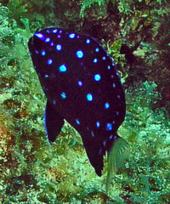
Parrotfish: Parrotfish are large for reef fish, some growing over a foot long. They're some of the most noticeable of all Virgin Islands sea life on the reefs. They're roughly the shape of a flattened football, and have teeth which are fused together to form tough, parrot-like beaks. They use these beaks to crunch through the hard corals that they feed on. Their feeding makes an audible crunching sound that you can hear when snorkeling or diving near them.
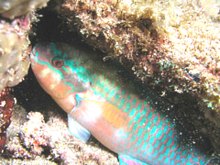
Wrasses: Wrasses are colorful fishes shaped like willow leaves. They come in many different sizes and colors. You see them darting about among the corals, feeding on tiny animals with their small mouths. One of the most interesting species of wrasse is the Cleaner Wrasse, a two-inch long fish with black and pale blue bands running down the length of its body. Cleaner Wrasses establish "cleaning stations" where other fish come to allow the cleaners to pick the parasites off of their skin. It's quite a sight to see a fierce-looking barracuda or giant grouper calmly allowing these tiny helpers to swim into their gaping mouths unharmed!
Pufferfish: These are fat, blunt-faced, slow moving fish that you often see tucked under coral ledges. When frightened or threatened, they suck water in, swelling up like a balloon so that they become too wide for most predators to swallow. Some have spines, too!
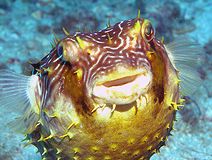
Grouper: Different species of grouper range in size from a few inches long to huge. The Giant Grouper can get bigger than a man! They can be brightly colored or dull gray or brown, depending on the variety. Groupers are bass-like fish. They have big jaws and gaping mouths that they use to swiftly engulf good-sized prey fish.
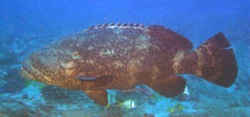
Squirrelfish: These are pinkish-red striped, large-eyed fish, about six inches long. They're shy, and you'll often see them hiding inside small chambers within the reef or at the base of sea-fans or sponges. Their big eyes help them hunt at night.
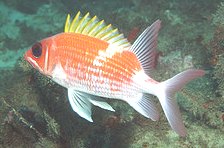
Angelfish: These flat-bodied fish are some of the most colorful of all reef fish. The juveniles are particularly colorful, with glowing, neon-blue, yellow, orange, and other colored bands or margins. The adults often become a subdued grayish color and can grow as big as a dinner plate.
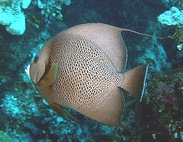
Seahorse: Seahorses hardly look like fish at all, with their upright posture, horse-like heads, and curly, prehensile tails! You can spot them on sea-grass beds and hanging around the base of sea-fans and soft corals. They use their small mouths to vacuum up tiny fish and shrimp. You can find a colony of them beneath the Frederiksted Pier.
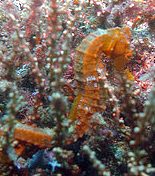
Jacks: Jacks are fast-swimming fish of the open water. They resemble miniature tuna, and form schools which often come onto the reefs from open water to prey on the small fish that live near the coral. The yellowtail jack is one of the most common. You sometimes see them come slashing into the middle of a giant school of minnow-like silversides to snap up these small fish.
Barracuda: Some of the scariest looking of all Virgin Islands sea life! Big, silvery, torpedo-shaped fish with a mouthful of sharp teeth. Barracudas are actually pretty harmless to people if left alone. These toothy predators can grow to over five feet long. You sometimes see them simply floating, suspended motionless above the sea floor.
Stingray: You find stingrays on flat, sandy bottoms, often near the reefs. Their flat, diamond-shaped bodies are ideal for concealing themselves in the sand. They lie completely still, covered with sand with just their eyes protruding. From this position they ambush small passing fish and other creatures. They have a barbed stinger in their tails which they can whip into any predator which attacks them. Be careful not to step on one!
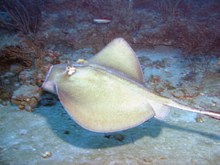
Virgin Islands Sea Life: Invertebrates
Besides the corals themselves, you'll find a huge number of different kinds of invertebrates among Virgin Islands sea life. Here are a few of the ones you're most likely to come across.
Sea Urchins are primitive animals related to starfish. They have hundreds of sharp spines around a hard, spherical shell. They feed by mooving across the bottom or over rocks and coral, grazing on the algae growing there. You'll often see them in clusters within crevices in the reef or clinging to large boulders near the shoreline. The spines are fierce! Be sure not to step on or brush against a sea urchin!
Sponges are some of the most primitive multi-celled animals of all Virgin Islands sea life. They anchor to patches of coral or rock, growing into long, vase-like structures. They spend their lives filtering sea-water through their bodies to extract the microscopic nutrients. They are often quite colorful, frequently bright red or orange. You sometimes see small fish, shrimp, or crabs living right inside the chamber of a sponge.
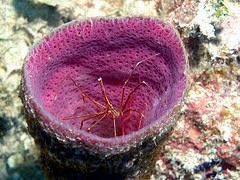
Hermit Crabs: There are many different species of hermit crabs, which are distinguished by the way they take up empty snail shells to move around in.
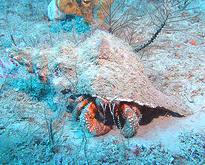
Squid: Reef squid can be seen near shoreline or around the reefs, often in small groups. They're about six inches long, with pointy "heads", big eyes, and tentacles protruding behind. It's hard to believe that these active, fast-swimming, alert animals are molluscs, related to clams, oysters and snails!
Spiny Lobster: Clawless relatives of the Maine lobster, these crustaceans hide under coral ledges and in crevices in the reef. Don't try to touch them! They can and will jab their spiny "horns" into you're hand if you reach for them. Very popular for food, this is the lobster you see on the menus of many restaurants in the Virgin Islands. They are tasty, for sure!
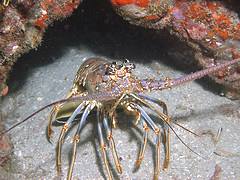
Return from Virgin Islands Sea Life to Nature in the Virgin Islands
Return from Virgin Islands Sea Life to Homepage














